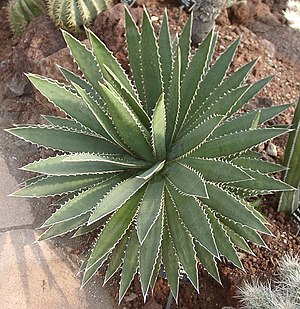Agave funkiana
| Agave funkiana | ||||||||||||
|---|---|---|---|---|---|---|---|---|---|---|---|---|

Agave funkiana |
||||||||||||
| Systematics | ||||||||||||
|
||||||||||||
| Scientific name | ||||||||||||
| Agave funkiana | ||||||||||||
| K.Koch & CDBouché |
Agave funkiana is a plant from the genus of the Agave ( agave ). English common names are "Blue Lechuguilla" and "Century Plant".
description
Agave funkiana grows with open rosettes from 1.2 to 1.8 meters in diameter that form numerous runners . The firm, radiating, straight or somewhat sickle-shaped, protruding leaves are linear. They are broadly encompassing the stem at the base. The yellowish green to dark green leaves often have a light central stripe and are usually 60 to 80 centimeters long and 3.5 to 5.5 centimeters wide. They are convexly thickened on the underside, but concave on the top. The brown to gray, thin leaf margin is almost straight and horny. At a distance of 1 to 2.5 centimeters there are mostly downwardly directed, slender marginal teeth 3 to 5 millimeters in length between which there are some irregularly arranged small intermediate teeth. The conical-awl, brown to white terminal spine is 1 to 3 centimeters long and furrowed narrow to open on the upper side.
The 3.5 to 4.5 meter high, slender, spiked inflorescence has loose partial inflorescences with paired, approximately 40 to 45 millimeters long flowers in the upper half . Their tepals are light glaucous green, with 20 to 24 millimeter long tips. The flower tube is 3.5 to 4 millimeters long.
Systematics and distribution
The first description was published in 1860 by Karl Heinrich Koch and Carl David Bouché .
Agave funkiana is a representative of the Marginatae group . It is closely related to Agave lophantha . However, there are differences in size and leaf structure.
Agave funkiana is grown in the Huntington Botanical Gardens in San Marino, California. The species can survive short periods of frost down to minus 5 ° C when dry.
use
Their fibers are used for brush production. With an average length of 0.97 millimeters and a diameter of 30.3 micrometers, the individual cells are very short and thick and therefore cannot be spun (minimum length required: 25 millimeters). Therefore fiber bundles are processed.
proof
literature
- Howard Scott Gentry: Agave funkiana . In: Agaves of Continental North America . University of Arizona Press, 1982, pp. 126-128, 139-141.
- J. Thiede: Agave funkiana . In: Urs Eggli (Hrsg.): Succulent lexicon. Monocotyledons . Eugen Ulmer, Stuttgart 2001, ISBN 3-8001-3662-7 , p. 31.
Individual evidence
- ↑ Weekly of the Association for the Promotion of Horticulture in the Royal Prussian States for Horticulture and Herbology . Volume 3, 1860, p. 47.
- ↑ Gentry: Agaves of Continental North America . 1982, p. 140
- ↑ C. Yu: Sisal. In: Robert Franck (ed.): Bast and other plant fibers , Cambridge / Boca Raton, 2005, pp. 229-273, ISBN 1855736845 / ISBN 0849325978
further reading
- August J. Spread: Agave funkiana . In: The Agaves . The Cactus & Succulent Journal Yearbook, 1968, pp. 8-9.
- Thomas Heller: Agave funkiana . In: agaves . Münster 2006. pp. 88-89.